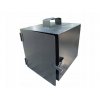The Basics of Smoking Meat in a Wooden Smoker
Learn how to choose the right wood, control the temperature, and prepare your meat for tender, flavorful, beautifully smoked results. Home smoking is easier than you think!
Introduction: The Aroma of Smoke and the Art of Tradition
Smoking food is an ancient culinary art, cherished for centuries in Central Europe.
By definition, smoking is “the preparation of food using hot or cold smoke produced by burning wood.”
At its heart, it’s all about the harmony of fire, wood, and time. A clean, steady stream of smoke is the foundation of every great smoking session — whether you use a traditional wooden smoker with a firebox or a modern electric smoker with a smoke generator.
1️⃣ Choosing the Right Wood
The foundation of good smoking is dry, untreated hardwood. Poor-quality or damp wood can ruin your work completely.
Best Woods for Smoking
Beech, alder, birch, maple, ash, acacia, and fruitwoods such as cherry, apple, or plum.
These woods produce a mild smoke, beautiful color, and a balanced flavor.
Avoid
-
Conifers (spruce, pine) — contain resins that make the meat bitter and dark.
-
Chemically treated, painted, wet, or moldy wood.
-
Sawdust or wood waste from construction materials.
Ideal smoking wood should be air-dried for 2–3 years, stripped of bark, and 2–3 fingers thick. Such wood burns evenly and produces light, clean smoke.
2️⃣ How to Maintain the Fire Properly
The fire is the heart of your smoker.
Inside the firebox, there should be a steady, gentle flame producing light-colored smoke. This smoke flows through the chamber, surrounds the meat, and exits freely through the chimney.
Never trap the smoke — during long smoking sessions, it must circulate freely to prevent bitterness.
For short smoking sessions (like cheese or sausages), you may partially close the chimney, but for longer ones, keep it open.
3️⃣ Essential Smoking Rules
Before Smoking
-
The meat must be dry — wet meat attracts soot and turns black.
-
Preheat your smoker — meat should always go into a warm chamber.
-
Meat pieces must not touch each other or the smoker walls.
During Smoking
-
Add small logs regularly.
-
Watch the temperature and smoke color — dark smoke means something’s wrong.
-
Avoid opening the smoker unnecessarily — it releases both heat and aroma.
4️⃣ Recommended Temperatures and Smoking Times
| Type of Food | Temperature (°C) | Smoking Time |
|---|---|---|
| Lean fish | 70–80 | approx. 3 h |
| Fatty fish | 65–80 | 3–5 h |
| Pork belly / neck (1 kg) | 65–75 | 6–9 h |
| Chicken / duck breast with skin | 80–90 | 3–4 h |
| Chicken / duck legs with bone | 80–90 | 3–4 h (boil 20–30 min before smoking) |
| Raw sausages | 65–75 | 5–7 h |
5️⃣ Preparing Meat for Smoking
Quality meat is the key to success. Ideal pieces weigh 0.5–1 kg.
Meat with bones spoils faster, so shorten the curing time compared to boneless cuts.
Salting and Curing
Typical salt ratio: 15–20 g per kg of meat.
You can add garlic, bay leaves, juniper, or curing salt (Prague powder) — this gives meat its pink color and longer shelf life.
There are two methods: dry curing (rubbing salt into the meat) or wet curing (soaking in brine).
✅ Pro Tip:
Use a vacuum sealer — season and salt the meat, place it in a vacuum bag, extract the air, and seal. The meat can last in the fridge for up to a month, and the flavor will distribute evenly.
Before smoking, rinse the meat, pat it dry, hang it on hooks, and let it air-dry at room temperature.
Conclusion: The Magic of Clean Smoke
If you stick to the basics — dry wood, steady fire, and clean smoke, your reward will be perfectly smoked meat with unmatched color, aroma, and taste.
Whether you use a wooden or electric smoker, home smoking brings authentic flavor and satisfaction every time.









